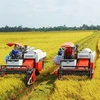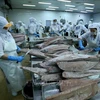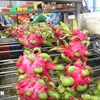Representatives from the Southeast and Central Highlands regions gathered on June 18 to discuss measures to sustainably shape their peppercorn industry.
Participants considered conforming to proven technical processes a key action.
Accordingly, regional provinces should plan pepper plantations and manage production in collectives to boost experience sharing and cut costs.
Growing, processing and preservation methods require thorough research and careful application and agricultural promotion programmes need to be launched more often.
Concerning related commercials activities, local authorities and producers ought to strengthen business links with major and demanding markets such as the EU, the US and Japan, and seek new markets from the Middle East and Africa.
Meanwhile, domestic enterprises working in the sector should work to strengthen their connection with growers to build direct purchase networks across the regions.
The forum also set a target for Vietnam to have 50,000 hectares of peppercorn plantations nationwide by 2020, 81 percent of which will concentrate in the two regions. Thus, annual total yield is expected to reach 140,000 tonnes, 90 percent of which will be high-quality, and overall export revenue will be recorded up to 1.3 billion USD.
Vietnamese peppercorn plantations have increased substantially to 86,000 hectares in recent years. The industry is now facing difficulties posed by rapid plantation expansion, intensive farming and poor techniques.
The nation posted a total pepper production of 152,000 tonnes in 2014.-VNA
Participants considered conforming to proven technical processes a key action.
Accordingly, regional provinces should plan pepper plantations and manage production in collectives to boost experience sharing and cut costs.
Growing, processing and preservation methods require thorough research and careful application and agricultural promotion programmes need to be launched more often.
Concerning related commercials activities, local authorities and producers ought to strengthen business links with major and demanding markets such as the EU, the US and Japan, and seek new markets from the Middle East and Africa.
Meanwhile, domestic enterprises working in the sector should work to strengthen their connection with growers to build direct purchase networks across the regions.
The forum also set a target for Vietnam to have 50,000 hectares of peppercorn plantations nationwide by 2020, 81 percent of which will concentrate in the two regions. Thus, annual total yield is expected to reach 140,000 tonnes, 90 percent of which will be high-quality, and overall export revenue will be recorded up to 1.3 billion USD.
Vietnamese peppercorn plantations have increased substantially to 86,000 hectares in recent years. The industry is now facing difficulties posed by rapid plantation expansion, intensive farming and poor techniques.
The nation posted a total pepper production of 152,000 tonnes in 2014.-VNA



















